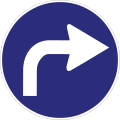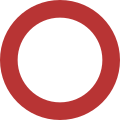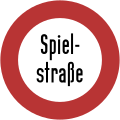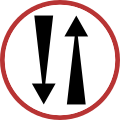Illustration of the traffic signs in the German Democratic Republic from 1956 to 1964
The picture table of the traffic signs in the German Democratic Republic from 1956 to 1964 shows the traffic signs in the German Democratic Republic (GDR) as they are by the Road Traffic Regulations (StVO) of October 4, 1956 as a regulation on behavior in road traffic (road traffic Regulation - StVO -) were introduced by the Council of Ministers of the GDR and became valid for East Berlin by ordinance of November 23, 1956 .
With the Road Traffic Regulations of October 4, 1956, the Council of Ministers on the one hand suspended the previous StVO from 1937 , but on the other hand also confirmed many of its basic regulations in words and pictures. Overall, new developments and findings in road traffic were addressed and these were adapted to the conditions in the German Democratic Republic. The time of publication of the GDR StVO from 1956 was only a few months after the publication of an amendment to the StVO from 1937 in the Federal Republic of Germany . A comparison of the two StVOs, which appeared in the same year, makes it clear that a number of signs newly introduced in the Federal Republic (see illustration of the road signs in the Federal Republic of Germany from 1956 to 1971 ) also appeared in the GDR StVO. Among other things, the comparable but independent further development of the direction arrow was interesting. With the StVO of 1956, the GDR adopted fundamentally updated specifications from various international conventions, such as the color of the arrow image.
In jurisprudential circles in the GDR, a statement by the Ministry of Justice and the public prosecutor's office was astonishing, according to which "even a negligent violation of the road traffic regulations by a cyclist, motorist or pedestrian in urban traffic ... is an expression of the intensified class struggle" . To smooth things over, the “Commission of the Central Committee for the Review of Affairs of Party Members” announced in the SED central organ “ Neues Deutschland ” on June 21, 1956 that ministers and lawyers had been misled by “alien theorists” .
After the traffic volume increased significantly until 1964, a new revision of the StVO was necessary at that time.
Direction arrow
Colours

After those responsible in the GDR wanted to break away from the standards such as RAL and DIN , which were continued after the war in West Germany , in order, among other things, to underline the sovereignty of their state, one of the country's major projects was to promote a new industry standardization. The mass of old standards that had to be redefined, as well as the constantly changing requirements due to innovations in research and technology, made this work a Sisyphean work . In the GDR, the DIN standards from 1955 onwards were compared to the TGL standard ( technical standards, quality regulations and delivery conditions ). Only with the mandatory requirements of the TGL 10629 (guidance systems for road traffic), which were introduced on January 1, 1968, were all essential standards relating to traffic signs fully covered. At the time of the introduction of the Road Traffic Regulations in 1956, the world of signs and colors from the pre-war period was part of everyday life. The early colors were therefore still based on the RAL color register 840 R, which was published during the war. With the type color card 5/62, which was published in 1962, the first GDR-specific color standardization came into effect.
The following colors were used for the traffic signs:
- Type color card 5/62: 3000 "red" (= no equivalent in RAL = TGL 21196 (1969): 0605 "signal red")
- Type color card 5/62: 1904 "yellow" (= no equivalent in RAL = TGL 21196 (1969): 0209 "chrome yellow")
- Type color card 5/62: 5903 "blue" (= no equivalent in RAL = TGL 21196 (1969): 1553 "dark blue")
The perceptible spectrum of colors in the 1976 CIE-Lab color space is given by TGL 21196, which came into effect on March 1, 1988. Although this TGL was created long after the StVO came out of force in 1964, the TGL color values were first brought into a form usable for image processing programs. So the color values could also be used for the illustrations in this article.
The basic colors for the traffic signs of the StVO were only defined with the unspecific designations red, yellow, blue etc. With these basic colors, the TGL 0-6163 published in November 1962 could be used to define the desired color spectrum and to select the closest color from the type color card. The TGL 0-6163 was based directly on the West German DIN 6163 "Colors and color limits for signal lights".
Manufacturing
At that time, many signs were manufactured using the long-lasting enamel technique, with mostly only the border being plastically folded to increase the stiffness of the sign and thus prevent the enamel from flaking. Signs in which the motif was depicted in a raised manner were less common in this technique. Most of the signs, however, were cut from rolled sheet iron , the motifs mostly being applied by the sign painters using stencils . Both techniques - sheet iron signs and refractory enamel - were recommended. However, since sheet iron was in short supply at the time, wooden signs, iron signs and plastic signs were recommended as alternatives.
Despite standard specifications, these templates sometimes differed greatly from one another for one and the same motif. Tin signs were much cheaper to produce than enamel signs, but they didn't last as long. Due to their sometimes very long running times, many characters had to be repaired or repainted several times. In the first case, at least, the retouchers could not use stencils. Together with a later increasing shortage economy , in which standard colors often had to be dispensed with, signs could often take on individualized features. This also applied to the typographically designed signposts and place-name signs.
In order to achieve a reflective effect of the signs, as did the self-adhesive Scotchlite reflective film, which had been used for a long time in West Germany , their effect was imitated by the manufacturers sprinkling tiny glass spheres into the still wet paint, whereby the durability of this technology was dependent on the location. On the other hand, GDR engineers had already developed their own reflective coating in the 1950s that could be used for traffic signs and guidance systems.
Attachment
The signs usually had to be attached to round posts made of iron pipe with a diameter of eight centimeters using iron clamps. But they could also be attached to street lamps, traffic poles and the like. Signposts had to be illuminated in the dark. This lighting should be part of public lighting. Before putting them up, enamel signs should be attached to a board with wood screws and rubber pads. This underlay should prevent the enamel from flaking off while the screws are being tightened.
I. Warning signs
II. Prohibition signs
III. Mandatory sign
IV. Signs
V. Traffic control systems
Guiding stones and guide pegs
The provisions of the provisional guidelines for the expansion of rural roads (RAL 1937) from December 1942 continued to apply in the GDR. They were only slightly modified in terms of text, as confirmed in the textbook Routing in Road Construction from March 1956. After that, the "guiding stones" should be made of light-colored and weather-resistant natural stone if possible. Concrete blocks should only be used in exceptional cases, for example if natural stones are missing or their freight costs are too high. The traffic safety measures established in 1942 continued to apply:
- 1. Guide stones and guide pegs,
- 2. Tree mirror,
- 3. Protective systems (railings and parapets),
- 4. Hyphens.
As the specific information in the textbook Routing in Road Construction shows , the dimensions of the stones and their color design remained identical, whereby an illustration - as in 1942 - could be dispensed with.
Stop signs for trams and motor vehicle lines
The signs stop for trams and stop for motor vehicles were originally published in the Reichsverkehrsblatt (RVkBl) in 1939, but were not included in the road traffic regulations. The ordinance from the Reichsverkehrsblatt with the stop signs for trams contained therein remained unaffected by the new ordinance on the construction and operation of trams (BOStrab) of December 8, 1959, which came into force on April 1, 1960 . The new BOStrab only repealed the previous ordinance from 1937. In its facilities, the BOStrab confirmed the previous stop signs for trams from 1959. The stop sign for motor vehicle lines continued to apply in its familiar form.
Highway sign
At this time, the motorway signs were not yet part of the road traffic regulations and were regulated separately. Since the large motorway signs were still hand-painted by various sign painters at that time, the texts and drawings visually differed from each other. The design of the blue symbols was based on the pre-war standards.
literature
- Ordinance on conduct in road traffic (road traffic regulations - StVO -) of October 4, 1956. In: Law Gazette of the German Democratic Republic Part I, No. 103, Berlin, November 20, 1956, pp. 1239–1251.
- Günther Mellenthin: Driving in a column. The new traffic signs in accordance with the Road Traffic Act of October 4, 1956. Addendum . Publishing house of the Ministry of National Defense, 1956
- Rolf Jedicke: Ordinance on behavior in road traffic - Road Traffic Regulations (StVO) - of October 4, 1956 . In: German road traffic . Special issue, November 1956
Web links
Remarks
- ↑ Law Gazette of the German Democratic Republic Part I, No. 103, Berlin, November 20, 1956, pp. 1239–1251.
- ^ Siegfried Mampel : The Soviet Sector of Berlin. An analysis of its external and internal status . Metzner, Frankfurt a. M. 1963, p. 315.
- ↑ Law Gazette of the German Democratic Republic Part I, No. 103, Berlin, November 20, 1956, pp. 1239–1251; here: p. 1250.
- ↑ Federal Law Gazette Part I, No. 19, date of issue: Bonn, April 30, 1956, p. 217.
- ↑ See: Federal Law Gazette Part I, year 1956, No. 19, date of issue: Bonn, April 30, 1956, p. 359 and Law Gazette of the German Democratic Republic, Part I, No. 103, date of issue: Berlin, November 20 1956, Ordinance on Conduct in Road Traffic (Road Traffic Act - StVO -) of October 4, 1956 , § 4, III. Mandatory sign.
- ↑ Falco Werkentin : Political criminal justice in the Ulbricht era. From avowed terror to covert repression . Links, Berlin 1997, ISBN 3-86153-150-X , pp. 346-247; Siegfried Prokop : 1956 - GDR at a crossroads. Opposition and new concepts of intelligence . Homilius, Berlin 2006, ISBN 3-89706-862-1 , p. 83.
- ↑ See in particular: TGL 10629, sheet 2: Control systems for road traffic - traffic signs - signs; TGL 10629, sheet 3: Control systems for road traffic - traffic signs - symbols, color, writing
- ↑ TGL 21196 (January 1969): Paints - color register
- ↑ TGL 21196 (June 1987): Paints - Color Register - Preferred Colors
- ↑ a b Theodor Menken, Paul Gleibe: Handbook of urban road construction and urban street cleaning . Verlag Technik, Berlin 1956. p. 176.
- ↑ Industry reports: Scotchlite reflective film for sea mark purposes In: Hansa. Central organ for shipping, shipbuilding, harbor , 94, 29/30, 1957, p. 1640, published weekly .
- ^ K. Linemann: Contribution to the discussion on the essay Lukacs. In: building planning. Bautechnik , 12, 1958, p. 83.
- ^ Theodor Menken, Paul Gleibe: Handbook of urban road construction and urban street cleaning . Verlag Technik, Berlin 1956. p. 174.
- ^ Erwin Fuchs: Lines in road construction , Fachbuchverlag Leipzig, Leipzig 1956, p. 139.
- ^ Order of the Reich Minister of Transport for the introduction of uniform stop signs for trams and motor vehicle lines . In: Reichsverkehrsblatt B, No. 33 of July 29, 1939
























































































